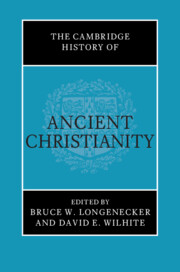Book contents
- The Cambridge History of Ancient Christianity
- The Cambridge History of Ancient Christianity
- Copyright page
- Contents
- Figures
- List of Contributors
- Editors’ Preface
- Part I Contested Contexts
- Part II Contested Figures
- Part III Contested Heritage
- 9 Jews and Christians in Pagan Antiquity
- 10 The Marcionite Option
- 11 The Gnostic Options
- 12 Early Christian Involvement in Classical Education, Literature, and Philosophy
- 13 Scriptures and Interpretations in Early Christian History
- Part IV Contested Cultures
- Part V Contested Beliefs
- Part VI Contested Bodies
- Ancient Sources
- Modern Authors
- References
10 - The Marcionite Option
from Part III - Contested Heritage
Published online by Cambridge University Press: 23 August 2023
- The Cambridge History of Ancient Christianity
- The Cambridge History of Ancient Christianity
- Copyright page
- Contents
- Figures
- List of Contributors
- Editors’ Preface
- Part I Contested Contexts
- Part II Contested Figures
- Part III Contested Heritage
- 9 Jews and Christians in Pagan Antiquity
- 10 The Marcionite Option
- 11 The Gnostic Options
- 12 Early Christian Involvement in Classical Education, Literature, and Philosophy
- 13 Scriptures and Interpretations in Early Christian History
- Part IV Contested Cultures
- Part V Contested Beliefs
- Part VI Contested Bodies
- Ancient Sources
- Modern Authors
- References
Summary
From the point when Justin Martyr first introduced Marcion (his more-or-less contemporary), as “even now teaching those who are persuaded to acknowledge another God greater than the creator (demiurge)” and causing “many to utter blasphemies” (1 Apol. 26.5, 58.1–2; cf. Dial. 35.5–6), Marcion has been given the role of arch-heretic and even archetypical heretic. Yet, perhaps more than most of his peers in the catalogues of heresies that so preoccupied early Christian writers, he has not just maintained an enduring fascination but among some modern interpreters has enjoyed considerable rehabilitation by symbolizing alternative accounts of early Christianity or the path it might have taken. Although the earliest polemical accounts provide little more biographical information about him than they do about most of those peers, his individual persona was not swallowed up by the system associated with him, but retained its renown as it was augmented in the developing tradition, swiftly becoming part of the received “knowledge” of who he was; from his (probably reliable) origins in Pontus and subsequent presence in Rome as reported by Justin, in the tradition that ensued Marcion becomes a shipmaster or -owner, specifically identified with Sinope, responsible for the seduction of a virgin, even son of a bishop, excluded from the church either at home by his father or/and from the church in Rome, perhaps following disappointment at failing to achieve some sort of status there. Most of this is a combination of widespread heresiological stereotypes and of vivid imagination, but in whole or in part it has too often been simply repeated even by more recent interpreters.1 This is no doubt largely due to the desire to answer the questions provoked whenever “an author” is supposedly identified – why did they take the precise theological steps and develop the particular theological system with which they were credited?
- Type
- Chapter
- Information
- The Cambridge History of Ancient Christianity , pp. 228 - 249Publisher: Cambridge University PressPrint publication year: 2023



